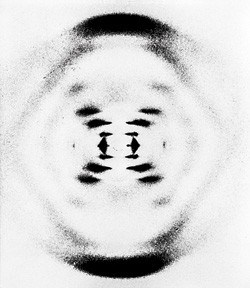| A | B |
|---|
| removed "nuclein" from white blood cell nuclei | Miescher |
| completed the transformation experiment in which nonencapsulated bacterium became encapsulated | Griffith |
| identified DNA as the transforming substance using protease, ribonuclease and deoxyribonuclease | Avery, McLeod and McCarthy |
| used radioactive viruses to prove DNA is the genetic material | Hershey & Chase |
| developed the structural model of DNA | Watson & Crick |
| a nitrogenous base, pentose sugar and phosphate | nucleotide |
| adenine & guanine | purines |
| cytosine, thymine and uracil | pyrimidines |
| describes the repetative nature of DNA's molecule | polynucleotide |
| bond between sugars and phosphates | covalent |
| bond between bases | hydrogen bonds |
| the end of a DNA molecule which carries a phosphate | 5' |
used X-ray crystallography to discover DNA's helical nature,  | Rosalyn Franklin |
| discovered the 1:1 ratio of adenine to thymine then guanine to cytosine | Chargaff |
| DNA coils around these proteins to be able to condense | histones |
| Molecule originally suspected of being the genetic material | protein |
| nucleic acid lacking thymine | RNA |
| the sugar in RNA | ribose |
| strong bond between atoms | covalent bond |
| DNA has instructions to make these biomolecules | proteins |
| The number and ___ of nucleotides is highly important | order |
| different types of cells make different types of ____ . | proteins |
| all cells in an organism have the ___ DNA. | same |